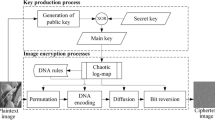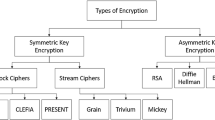Abstract
An advanced image encryption scheme should equip the capability against malicious attacks, reduce the losses under attacks, and improve the compression rate tremendously due to the unsafe network environment and the limited bandwidth resources. Recently, compressive sensing (CS) has been introduced into image encryption schemes because of the merit of low sampling rate. However, these schemes still cannot address the above requirements well. In order to improve compression rate while providing higher security level, a novel subdata image cryptosystem is proposed by introducing vector quantization (VQ) into CS-based encryption scheme. The plaintext image is first divided into VQ index blocks and the error compensations that are sparse enough to be compressed by CS. Then, the index information and CS measurements are further scrambled and diffused by chaotic sequences to achieve enhanced security. It can be ensured that the primary index information is informative and occupies smaller proportion of cipher image such that it cannot be easily tampered if only a part of the image is attacked. In contrast, the secondary error information is a good supplement to the former and occupies larger proportion. Simulation results verify that our proposed scheme has overwhelming compression rate and security effect to resist malicious attacks when compared with the state-of-art schemes. In addition, even if the important information is damaged, the destroyed pixels can be located and the plaintext image can be reconstructed with VQ neighbor indexes.












Similar content being viewed by others
References
Zhang YS, Wen WY, Wu YF, Zhang R, Chen JX, He X (2017) Deciphering an RGB color image cryptosystem based on Choquet fuzzy integral. Neural Comput Appl 28(1):165–169
Liu X, Liu W, Ma H, Fu H (2016) Large-scale vehicle re-identification in urban surveillance videos. In: 2016 IEEE international conference on multimedia and expo (ICME), pp 1–6
He Y, Zhang YQ, Wang XY (2018) A new image encryption algorithm based on two-dimensional spatiotemporal chaotic system. Neural Comput Appl. https://doi.org/10.1007/s00521-018-3577-z
Zhang YQ, He Y, Wang XY (2018) Spatiotemporal chaos in mixed linear-nonlinear two-dimensional coupled logistic map lattice. Phys A 490(2018):148–160
Zhang YQ, Wang XY, Liu LY, He Y, Liu J (2017) Spatiotemporal chaos of fractional order logistic equation in nonlinear coupled lattices. Commun Nonlinear Sci Numer Simulat 52(2017):52–61
Chai XL, Gan ZH, Yuan K, Chen YR, Liu XX (2017) A novel image encryption scheme based on DNA sequence operations and chaotic systems. Neural Comput Appl. https://doi.org/10.1007/s00521-017-2993-9
Zhang YQ, Wang XY, Liu J, Chi ZL (2016) An image encryption scheme based on the MLNCML system using DNA sequences. Opt Lasers Eng 82(2016):95–103
Ping P, Xu F, Mao YC, Wang ZJ (2017) Designing permutation-substitution image encryption networks with Henon map. Neurocomputing 283:53–63
Gan ZH, Chai XL, Han DJ, Chen YR (2018) A chaotic image encryption algorithm based on 3-D bit-plane permutation. Neural Comput Appl. https://doi.org/10.1007/s00521-018-3541-y
Xing Y, Pesquet-Popescu B, Dufaux F (2013) Vector quantization for computer generated phase-shifting holograms. In: 2013 Asilomar conference on signals, systems & computers, pp 709–713
Yan B, Bai S (2017) Design of image confusion-diffusion cryptosystem based on vector quantization and cross chaotic map. In: 2nd international conference on image, vision and computing, pp 639–644
Zhang Y, Zhang LY (2015) Exploiting random convolution and random subsampling for image encryption and compression. Electron Lett 51(20):1572–1574
Candès EJ, Tao T (2004) Near-optimal signal recovery from random projections: universal encoding strategies? IEEE Trans Inf Theory 52(12):5406–5425
Zhou NR, Zhang AD, Wu JH, Pei DJ, Yang YX (2014) Novel hybrid image compression–encryption algorithm based on compressive sensing. Optik 125(18):5075–5080
George SN, Pattathil DP (2014) A secure LFSR based random measurement matrix for compressive sensing. Sens Imaging 15(1):1–29
George SN, Pattathil DP (2014) A novel approach for secure compressive sensing of images using multiple chaotic maps. J Optics-Uk 43(1):1–17
Zhou NR, Pan SM, Cheng S, Zhou ZH (2016) Image compression–encryption scheme based on hyper-chaotic system and 2D compressive sensing. Opt Laser Technol 82:121–133
Liu XB, Mei WB, Du HQ (2016) Simultaneous image compression, fusion and encryption algorithm based on compressive sensing and chaos. Opt Commun 366:22–32
Chai XL, Fu XL, Gan ZH, Zhang YS, Lu Y, Chen YR (2018) An efficient chaos-based image compression and encryption scheme using block compressive sensing and elementary cellular automata. Neural Comput Appl. https://doi.org/10.1007/s00521-018-3913-3
Fan HJ, Li M, Mao WT (2017) VQ-based compressive sensing with high compression quality. Electron Lett 53(17):1196–1198
Kasat NR, Thepade SD (2016) Novel content based image classification method using lbg vector quantization method with bayes and lazy family data mining classifiers. Procedia Comput Sci 79:483–489
Candès EJ, Romberg J, Tao T (2006) Robust uncertainty principles: exact signal reconstruction from highly incomplete frequency information. IEEE Trans Inf Theory 52(2):489–509
Orsdemir A, Altun H, Sharma G, Bocko M (2008) On the security and robustness of encryption via compressed sensing. In: 2008 military communications conference, pp 1–7
Huang R, Rhee K, Uchida S (2014) A parallel image encryption method based on compressive sensing. Multimed Tools Appl 72(1):71–93
Zhang YS, Xiang Y, Zhang LY, Rong Y, Guo S (2018) Secure wireless communications based on compressive sensing: a survey. IEEE Commun Surv Tut. https://doi.org/10.1109/Comst.2018.2878943
Khade PN, Narnaware M (2012) 3D chaotic functions for image encryption. Int J Comput Sci Issues (IJCSI) 9(3):323–328
Zhang YQ, Wang XY (2014) Spatiotemporal chaos in mixed linear–nonlinear coupled logistic map lattice. Phys A 402(2014):104–118
Liu H, Wen F, Kadir A (2019) Construction of a new 2D Chebyshev-Sine map and its application to color image encryption. Multimed Tools Appl 78(12):15997–16010
Liu H, Kadir A, Sun X (2017) Chaos-based fast colour image encryption scheme with true random number keys from environmental noise. IET Image Process 11(5):324–332
Parvin Z, Seyedarabi H, Shamsi M (2016) A new secure and sensitive image encryption scheme based on new substitution with chaotic function. Multimed Tools Appl 75(17):10631–10648
USC-SIPI Image Database, University of South California, Signal and Image Processing Institute, http://sipi.usc.edu/database. Last Accessed 16 March 2018
Zhu L, Song H, Zhang X, Yan M, Zhang L, Yan T (2019) A novel image encryption scheme based on nonuniform sampling in block compressive sensing. IEEE Access. https://doi.org/10.1109/ACCESS.2019.2897721
Wang Q, Li D, Shen Y (2016) Intelligent nonconvex compressive sensing using prior information for image reconstruction by sparse representation. Neurocomputing 224:71–81
Zhang LY, Wong KW, Zhang Y, Zhou J (2016) Bi-level protected compressive sampling. IEEE Trans Multimedia 18(9):1720–1732
Zhang YQ, Wang XY (2014) A symmetric image encryption algorithm based on mixed linear–nonlinear coupled map lattice. Inf Sci 273(2014):329–351
Wang XY, Teng L, Qin X (2012) A novel colour image encryption algorithm based on chaos. Signal Process 92(4):1101–1108
Wang XY, Liu LT, Zhang YQ (2015) A novel chaotic block image encryption algorithm based on dynamic random growth technique. Opt Lasers Eng 66:10–18
Hua ZY, Zhou YC, Pun CM, Chen CLP (2015) 2D sine logistic modulation map for image encryption. Inf Sci 297:80–94
Li C, Lin D, Feng B, Lü J (2018) Cryptanalysis of a chaotic image encryption algorithm based on information entropy. IEEE Access 6:75834–75842
Zhang YQ, Wang XY (2014) Analysis and improvement of a chaos-based symmetric image encryption scheme using a bit-level permutation. Nonlin Dyn 77(3):687–698
Zhang Y, Zhou J, Chen F, Zhang LY, Xiao D, Chen B, Liao X (2016) A block compressive sensing based scalable encryption framework for protecting significant image regions. Int J Bifurcat Chaos 26(11):1234–1247
Acknowledgements
This work was supported by the National Natural Science Foundation of China (Grant No.61602158) and the Key Scientific Research Plan of Henan Higher Education Institutions (Grant No. 20A413007).
Author information
Authors and Affiliations
Corresponding author
Ethics declarations
Conflicts of interest
The authors declare no conflict of interest.
Additional information
Publisher's Note
Springer Nature remains neutral with regard to jurisdictional claims in published maps and institutional affiliations.
Rights and permissions
About this article
Cite this article
Fan, H., Zhou, K., Zhang, E. et al. Subdata image encryption scheme based on compressive sensing and vector quantization. Neural Comput & Applic 32, 12771–12787 (2020). https://doi.org/10.1007/s00521-020-04724-x
Received:
Accepted:
Published:
Issue Date:
DOI: https://doi.org/10.1007/s00521-020-04724-x




